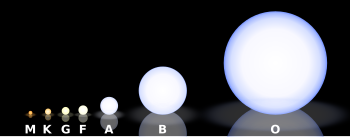HD 164595
| 观测资料 历元 J2000 | |
|---|---|
| 星座 | 武仙座 |
| 星官 | |
| 赤经 | 18h 00m 38.894s[1] |
| 赤纬 | +29° 34′ 18.92″[1] |
| 视星等(V) | |
| 特性 | |
| 光谱分类 | G2V D[1] |
| 详细资料 | |
| 质量 | 0.99 [2] M☉ |
| 表面重力 (log g) | 4.44 ±0.05 [2] |
| 温度 | 5790 ± 40 [2] K |
| 金属量 [Fe/H] | −0.06 [2] dex |
| 年龄 | 4.5[2] Gyr |
| 其他命名 | |
| 参考资料库 | |
| SIMBAD | 资料 |
| 资料来源: | |
| 依巴谷星表 | |
HD 164595[1]是位于武仙座的一颗G型主序星,距离地球28.927秒差距(〜94.302光年)[2][3],视星等7.075[1],使用双筒望远镜或小口径的天文望远镜,参考星图就可以在武仙座中山增一(武仙座ξ)旁边找到它。
行星
[编辑]HD 164595有一颗行星:HD 164595 b,但是可能还有其他类地行星。 HD 164595 b是已经被天文学家确认的系外行星,每40天绕行HD 164595一次,质量相当于16个地球。
与太阳比较
[编辑]下列表格列出太阳与HD 164595的特征:
| 名称 | J2000位置 | 距离 (光年) |
恒星分类 | 表面温度 (K) |
金属量 (dex) |
年龄 (亿年) |
注释 | |
|---|---|---|---|---|---|---|---|---|
| 赤经 | 赤纬 | |||||||
| 太阳 | — | — | 0.00 | G2V | 5,778 | +0.00 | 46 | [4] |
| HD 164595 | 18h 00m 38.9s | +29° 34′ 19″ | 94.302 | G2V | 5,790 | −0.06 | 45 | [5] |
这是一颗类太阳恒星,恒星光谱类型为G2V。它的表面温度为5,790K,相较于太阳的5,778K,两者极为相近。它的金属量为-0.06,比太阳(0.00)稍低;它的年龄约45亿年,略微比太阳(46亿年)年轻一些[5]。一些科学家已将它列为太阳2.0。真正的孪生太阳将会是G2V、5,778K、46亿年的年龄、0.1%的光度变化[6]。年龄在46亿年的恒星是最稳定的状态,适当的金属量和大小和低亮度的变化也都很重要的[7][8][9]。

SETI候选和信号报告
[编辑]在2015年5月15日,一个短暂、单一的11GHz(波长2.7厘米)的电波讯号[10]被拉坦-600电波天文台,包括克劳迪奥·梅肯在内的一组科学家观测到来自HD 164595的方向。这讯号可能是来自地面的电波频率干扰,或是经由重力透镜来自更遥远之处[11]。它只被单独一个团队,只在单独一架望远镜观测到一次(历时2秒钟),只符合里约等级[12]的1(无意义)或2(低)。发现的团队建议要持久的监测,但是在已经进行的39次观测,仍然只有这唯一的一次[13]。
这次的观测定于2016年9月27日在一次科学会议中提出简报[14],但Paul Gilster于8月27日它的部落格,半人马座星梦,提早披漏了这个讯息,过早引起公众的注意[15][16][17]。从2016年8月29日起,媒体的讨论引发这个信号可能来自第二型文明的各向同性灯塔的猜测[18][19]。SETI和METI正在使用艾伦望远镜阵和Boquete Optical SETI做后续的努力[20][21]。
SETI协会的资深天文学家赛斯·肖斯塔克告诉GeekWire网站说:"你真正想要的是另一架望远镜的确认,但......这是真的吗? 信号可能是真实的,但我怀疑那不是外星人的。这有可能是一个宽频信号或其他的可能性,它们来自自天然的来源(或甚至地面的干扰)造成[21]。德克萨斯州农工大学的天文学家尼可拉斯·桑泽夫告诉Ars Technica,信号是军用频道的,可能是一颗卫星讯号的下传,暗示这可能是个需要保密的系统,因此对SETI的科学家而言,都是未知的[10]。
加州大学柏克莱分校SETI研究中心的科学家[22]使用绿堤望远镜观察HD 164595,只是突破听计画的一部分。没有在拉坦-600报告的位置检测到暂态频率的信号[23][24]。
相关条目
[编辑]参考资料
[编辑]- ^ 1.0 1.1 1.2 1.3 1.4 HD 164595 – Star. SIMBAD. Centre de données astronomiques de Strasbourg. [13 July 2016]. (原始内容存档于2018-08-14).
- ^ 2.0 2.1 2.2 2.3 2.4 2.5 A photometric and spectroscopic survey of solar twin stars within 50 parsecs of the Sun page 7 & 11 & 17, 31 December 2013 (PDF). arxiv. Cornell University - Astronomy & Astrophysics manuscript. [13 July 2016]. (原始内容存档 (PDF)于2017-04-05).
- ^ Sky Map, HD 164595. [2016-08-27]. (原始内容存档于2017-04-04).
- ^ Williams, D.R. Sun Fact Sheet. NASA. 2004 [2009-06-23]. (原始内容存档于2015-12-01).
- ^ 5.0 5.1 Porto de Mello, G. F.; da Silva, R.; da Silva, L.; de Nader, R. V. A photometric and spectroscopic survey of solar twin stars within 50 parsecs of the Sun; I. Atmospheric parameters and color similarity to the Sun. Astronomy and Astrophysics. March 2014, 563: A52. Bibcode:2014A&A...563A..52P. arXiv:1312.7571
 . doi:10.1051/0004-6361/201322277.
. doi:10.1051/0004-6361/201322277.
- ^ NASA, Science News, Solar Variability and Terrestrial Climate, Jan. 8, 2013. [2016-08-27]. (原始内容存档于2017-11-06).
- ^ University of Nebraska-Lincoln astronomy education group, Stellar Luminosity Calculator. [2016-08-27]. (原始内容存档于2019-10-27).
- ^ National Center for Atmospheric Research, The Effects of Solar Variability on Earth's Climate, 2012 Report. [2016-08-27]. (原始内容存档于2017-12-31).
- ^ Most of Earth’s twins aren’t identical, or even close!, by Ethan on 5 June 2013. [2016-08-27]. (原始内容存档于2017-10-22).
- ^ 10.0 10.1 Berger, Eric. Ars Technica. Ars Technica. Ars Technica. [29 August 2016]. (原始内容存档于2019-05-11).
- ^ SETI observations on the RATAN-600 telescope in 2015 and detection of a strong signal in the direction of HD 164595 Bursov N., Filippova L., Filippov V., Gindilis L., Maccone C. et al. 2016 | in "IAA SETI Permanent Committee", Guadalajara, Mexico
- ^ Rio scale calculator. [2016-08-31]. (原始内容存档于2016-09-02).
- ^ Gilster, Paul. An Interesting SETI Candidate in Hercules. Centauri Dreams. 2016-08-29 [29 August 2016]. (原始内容存档于2018-01-10).
- ^ International Astronautical Congress 2016. [2016-08-31]. (原始内容存档于2018-12-14).
- ^ Gilster, Paul. An Interesting SETI Candidate in Hercules. 27 August 2016 [29 August 2016]. (原始内容存档于2018-01-10).
- ^ Boyle, Alan. They’re not saying it’s aliens, but signal traced to sunlike star sparks SETI interest. 29 August 2016 [29 August 2016]. (原始内容存档于2017-04-04).
- ^ Griffiths, James. Hear me now? 'Strong signal' from sun-like star sparks alien speculation. CNN. 30 August 2016 [30 August 2016]. (原始内容存档于2019-05-02).
- ^ Seemangal, Robin. Not a Drill: SETI Is Investigating a Possible Extraterrestrial Signal From Deep Space. 29 August 2016 [29 August 2016]. (原始内容存档于2017-12-24).
- ^ Zolfagharifard, Ellie. Is Earth being contacted by ALIENS? Mystery radio signals coming from a sun-like star baffle scientists. 29 August 2016 [29 August 2016]. (原始内容存档于2017-10-30).
- ^ 存档副本. [2016-08-31]. (原始内容存档于2018-01-24).
- ^ 21.0 21.1 存档副本. [2016-08-31]. (原始内容存档于2018-04-17).
- ^ Berkeley SETI Research Center. [2016-08-31]. (原始内容存档于2019-04-06).
- ^ Preliminary analysis of star HD 164595 (PDF). [2016-08-31]. (原始内容存档 (PDF)于2018-01-24).
- ^ Breakthrough Listen Follow-up of a Transient Signal from the RATAN-600 Telescope in the Direction of HD 164595 (PDF). [2016-08-31]. (原始内容存档 (PDF)于2019-01-12).
